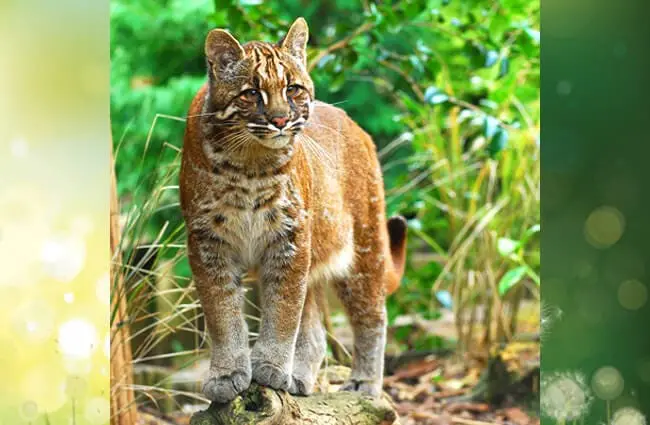There are two species of felines that people refer to as “Golden Cat” – the Asian Golden Cat and the African Golden Cat. Despite their similar names, these two species are not actually closely related.
The closest relative of the Asian species is the Bay Cat. Conversely, the closest relative of the African species is the Caracal and Serval. Read on to learn about the Golden Cat.
Description of the Golden Cat
Though they aren’t closely related, these two cat species look superficially similar. They are medium sized cats with reddish-brown coats and some spotted or dapple patterns.
Africans have blatant spots, while Asians have dapples and dark markings on their faces, chests, and legs. While both species usually weigh around 20 or 30 lbs. Asians grow much longer than Africans do.
Interesting Facts About the Golden Cat
These felines are robust little predators. Despite their small size, they are surprisingly ferocious. Learn more about what makes Golden Cats unique below.
- Elusive Cats – The African species is incredibly elusive and difficult to study. In fact, these little cats are so difficult to study in the wild that researchers obtain most of their information from animals in zoos.
- Varied Schedule – The Asian species don’t live by a strict schedule like some humans do. Instead of sleeping during the day and hunting at night, these cats sort of pick and choose when they are most active. During one study, researchers found that the cats were least active around one or two in the morning, and most active in mid-morning and late afternoon.
- Tiger’s Terror – Though this is obviously false, indigenous people believe that burning the hide of one of the Asians, or carrying a lock of their hair, wards away tigers. Of course, no scientific evidence suggests this, and tigers have no fear of these cats whatsoever.
Habitat of the Golden Cat
Both the African and Asian species of these cats live in dense forested habitats. The Asians live in mountainous regions, usually about 8,000 ft. above sea level. This species inhabits tropical and subtropical forests with high rainfall.
The African species also lives in forests, but they can live in areas that humans have cut down previously. Some of their favorite habitats are riparian or waterside regions, and forest edges. Africans also live in mountainous regions.
Distribution of the Golden Cat
The Asian and African species have different distributions. The African species has two primary regions that they inhabit, Central Africa and northwestern Africa. They live from the southern border of Senegal to Ghana, and from the Democratic Republic of Congo to the western coast.
The Asian species has spotty distribution across southeast Asia. They inhabit small pockets of suitable habitat from China to Malaysia.
Diet of the Golden Cat
Like most of the members of their family, these cats are carnivores and eat meat. Their specific food preferences vary based on where they live. Even within a species, the diet of one cat in China might be entirely different from the diet of another cat in Cambodia.
For the Asian species, some common prey items include muntjacs, which are a small deer species, ground squirrels, hares, birds, mice, rats, and even wild pigs. The African species feeds on small antelopes like duikers, monkeys, rodents, and birds.
Golden Cat and Human Interaction
Human interaction impacts both species of these cats. The exact dangers for each species vary slightly, but both cats suffer at the hands of humans directly and indirectly. Population numbers of both the African and Asian species are currently declining.
Habitat loss is one of the primary threats to both cats because they rely on dense vegetation to survive. Hunting and poaching also impacts both species, both for meat and fur. The IUCN lists the Asian Golden Cat as Near Threatened and the African Golden Cat as Vulnerable.
Domestication
Humans have not domesticated either species of Golden Cat.
Does the Golden Cat Make a Good Pet
No, these felines do not make good pets. Though relatively small, these cats are more than capable of defending themselves with sharp teeth and claws. They are not cuddly kitties, and do not like human interaction. In most places it is also illegal to own a Golden Cat as a pet.
Golden Cat Care
Much of the information that we know about these cats today comes from individuals in zoos. Because these cats live in dense jungles and forests, researchers find it difficult to make observations.
Zoos provide these cats with large enclosures to exercise and plenty of bushes, shrubbery, and other hiding places. Animals in zoos are important for the survival of the species, and conservation programs breed the cats and study their behavior.
Behavior of the Golden Cat
Though scientists do not have extensive information about their social structure, they believe these cats are primarily solitary and live alone. Their activity varies, but researchers believe that they are most active around dawn and dusk, or crepuscular.
These cats are so shy that it is difficult for scientists to study their behavior. However, like many cat species researchers believe that males have larger territories than females, and their ranges overlap with those of their female neighbors for breeding purposes.
Reproduction of the Golden Cat
When a female is receptive to breeding, she uses scent marking around her territory to attract a mate. While we know very little about the mating behavior of wild Golden Cats, studying animals in zoos helps us understand their reproductive rates.
After breeding, their gestation period lasts about two and a half months. Most litters contain two or three cubs, which are born blind and helpless. The cubs quickly grow and develop, and the mother weans them when they are between six weeks and six months old, depending on the species.











![Red Angus Closeup of a beautiful Red Angus cowPhoto by: U.S. Department of Agriculture [pubic domain]https://creativecommons.org/licenses/by/2.0/](https://animals.net/wp-content/uploads/2020/03/Red-Angus-4-238x178.jpg)












![Red Angus Closeup of a beautiful Red Angus cowPhoto by: U.S. Department of Agriculture [pubic domain]https://creativecommons.org/licenses/by/2.0/](https://animals.net/wp-content/uploads/2020/03/Red-Angus-4-100x75.jpg)

